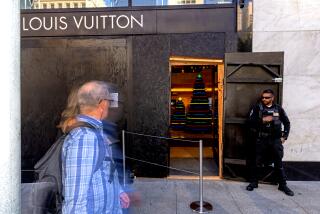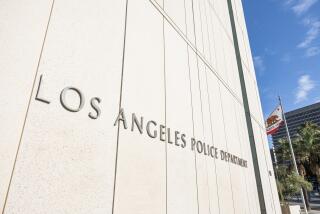Police, Sheriff’s Tallies of Crime Statistics Don’t Add Up : Law enforcement: City refuses to release 1991 figures until the agencies’ reports can be reconciled.
- Share via
LONG BEACH — Long Beach officials refused this week to release the city’s crime statistics for 1991, saying they are investigating inconsistencies in the numbers provided by the Police Department and by the Los Angeles County Sheriff’s Department.
The city manager’s office is investigating why crimes reported in the parts of town patrolled by sheriff’s deputies have been tallied differently by the Long Beach Police Department, which keeps crime statistics for the whole city.
“There are discrepancies that can’t be explained. Something is wrong with how the system is set up,” Assistant City Manager John Shirey said.
Shirey would not elaborate. But partial figures released in January by the Sheriff’s Department may provide a clue. They show that crime decreased substantially in areas patrolled by the Sheriff’s Department compared to areas patrolled by the Long Beach Police.
The crime statistics could be used to contend that the sheriff’s agency is doing a better job of fighting crime. And this year they are being tallied just as the Long Beach City Council is considering a proposal to abolish the 84-year-old Police Department and hire the Sheriff’s Department to patrol the city.
Shirey declined to say how the numbers differed or whether crime had decreased in the area. Officials with the Sheriff’s Department declined to discuss the figures, saying the city manager’s office is reviewing them.
Forty-three sheriff’s deputies have patrolled about a fifth of the city since November, 1990, when city officials hired them to help the understaffed Police Department.
The year-end crime figures are typically available by the end of January. But this year, they have been closely guarded by City Manager James C. Hankla since questions arose about their accuracy.
Officials looking into the discrepancies have found problems with a computer program at the Long Beach Police Department and with record-keeping at the Sheriff’s Department.
The computer glitch, which was distorting crime statistics within the council districts, has been corrected, Shirey said.
In the past few months, officials also realized that crimes occurring at intersections in areas patrolled by sheriff’s deputies were not tallied. “We discovered it and corrected it,” Shirey said.
But those problems do not account entirely for the discrepancies in the numbers, Shirey said.
Councilman Les Robbins raised the issue in December in a letter to Hankla. Robbins, who is also a sheriff’s deputy, questioned why Long Beach police revised figures for the third quarter of 1990. Police reported 446 additional crimes for July, August and September that year, an increase of 3.2% citywide, Robbins said.
In Robbins’ 5th District--taking council boundary changes into account--the revised figures showed a 6.1% increase in crime during the same period. Police also changed the third-quarter crime statistics for 1991, Robbins said.
“I believe (Long Beach police) inflated the number of crimes in my district,” Robbins said.
Robbins is concerned that the Long Beach Police Department is “trying to manipulate the sheriff’s figures so that (Long Beach police) can look better.”
But Shirey said that the difference in numbers does not necessarily make one agency look better than the other because the numbers vary from category to category.
Partial 1991 figures released by the Sheriff’s Department on Jan. 30, indicated that crime in areas patrolled by deputies was lower than in the rest of the city. Deputy-patrolled areas saw a 15.8% drop in crime last year, compared to a 3% increase in the police-patrolled sections of town, according to sheriff’s Sgt. Harry Bovie.
For more serious crimes, including murders, rapes and assaults, the Sheriff’s Department reported a 15% reduction, whereas Long Beach police reported a 1.2% increase for the same 12-month period, Bovie said.
Long Beach police Lt. Gary Halliday said the two agencies have discrepancies in how they count some misdemeanor and felony crimes, such as narcotics violations, drunk driving and forgeries. But Halliday declined to elaborate, saying that the city manager’s office is continuing its review.
Sheriff’s Lt. Marvin Cavanaugh, the liaison with Long Beach police, said that his department turns in its crime reports daily to the Police Department, which tabulates the figures and reports them to the state.
Although Shirey indicated that there are also some problems with the sheriff’s record-keeping, Cavanaugh said he was unaware of any irregularities.
More to Read
Sign up for Essential California
The most important California stories and recommendations in your inbox every morning.
You may occasionally receive promotional content from the Los Angeles Times.










